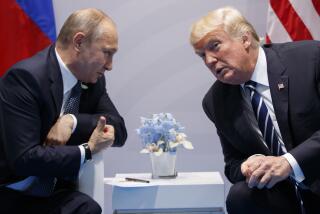When the Soviets Want Yes
- Share via
PARIS — Thirty-two years ago, in the spring of 1955, the Soviet Union suddenly decided to unblock negotiations on a peace treaty for Austria. Sixteen years later, in 1971, the Soviets decided it was time to settle the Berlin question with the Western Allies. Today, after 16 more years, the door is suddenly open for agreement to rid Europe of medium-range nuclear missiles.
There can only be speculation about the reasoning or political pressure in Moscow that produced each of these spectacular shifts in Soviet positions that previously had seemed embedded in concrete. But there are similarities in each case that are worth noting, and a lesson to be drawn for American negotiators.
In each case, the leader in the Kremlin liquidated a policy inherited from his predecessor, a policy that was not working, was up against a dead end and was no longer of any benefit to the Soviet Union.
In the case of Austria, it was Nikita S. Khrushchev who abruptly decided to change a policy inherited from the Stalin Era. Ten years after World War II, there was not the slightest chance of a communist takeover in Austria, despite the intimidating presence of Soviet occupation forces surrounding Vienna. Khrushchev badly wanted a meeting with President Dwight D. Eisenhower, and Secretary of State John Foster Dulles had made an Austrian peace treaty a precondition.
Suddenly the green light began to flicker in Moscow, and in May of 1955, after five years of deadlock, the text of a treaty was produced in barely a month’s time.
In the case of Berlin, Leonid I. Brezhnev was liquidating a dead-end policy inherited from Khrushchev, along with the Berlin Wall. A quarter of a century after the end of the war, after blockade and bluster, it was clear that nothing would ever force the Western Allies out of Berlin. Brezhnev wanted the Helsinki conference, and Secretary of State Henry A. Kissinger had said there would be no Helsinki negotiations until Berlin was settled first.
After a year of desultory negotiations, Brezhnev decided to settle, and it was done in a rush at the end of August, 1971.
Today, Mikhail S. Gorbachev is liquidating a policy inherited from Brezhnev, of stationing medium-range nuclear missiles in Western Europe. It is a policy that no longer benefits the Soviet Union; on the contrary, it has increased the nuclear threat to the Soviet homeland by attracting a flock of new American missiles to Europe.
For military and political reasons, Gorbachev has decided to go back to a “missile free” Europe, liquidating at the same time the “package deal” policy inherited from Andrei A. Gromyko that linked medium-range missiles and strategic missiles and curtailment of the U.S. Strategic Defense Initiative, the space-based system called “Star Wars.”
The second common denominator in these three strategic moves by the Soviet Union is the fact that they all involve relations with Europe. In each case there has been a definite diminution of military and political pressure against Europe, a gradual normalization of Soviet relations with Europe in place of the relentless confrontation that has been going on ever since the Red Army reached the Elbe River in the closing days of World War II.
Of course, after every relaxation of Soviet pressure, new pressure has been applied. But, looking back, the ultimate threat of war against Europe has gradually but steadily faded since Josef Stalin abruptly decided to give up on the Berlin blockade in 1949.
As it happened, I was on the first train into Berlin when the blockade was lifted. And in 1955, when signals on the Austrian treaty began to flicker from Moscow, I was sent to Vienna by the New York Herald Tribune.
The man to see was Llewellyn E. Thompson, the U.S. high commissioner. He had served in Moscow during the war and returned twice as ambassador in the 1960s, once during the Cuban missile crisis and later to lay the groundwork for what became the first strategic arms limitation talks in Helsinki. Thompson, with George Kennan and Charles E. Bohlen, was one of the gifted trio of our wartime and postwar Soviet experts--probably the most effective diplomat of the three.
“Well, where do we go from here?”
Thompson offered a revealing reply: “Dulles is shell-shocked--he never expected this. I’ve had no instructions but I’ve cabled him to let me handle it. If I understand the Soviets correctly, when they make a strategic decision like this to go for a treaty, tactical problems will not be allowed to hold things up. I am going back in there tomorrow and ask for everything that we have been asking for for the last five years. It’s all here in this file drawer.
“I know that the Austrians are in a hurry right now, and I’ll probably take a lot of flak here from them when the negotiations slow down. But just because the Austrians are in a hurry, I’m not going to see them saddled with a bad treaty.”
So this quiet, low-key American from Colorado hung in, often to the unease of his British and French counterparts--and of John Foster Dulles, who at one crucial point, was afraid that Thompson might be overplaying the hand. But Thompson was a great poker player; he knew when to check and when to raise. Austria got a good treaty, and Austrians like Bruno Kreisky, the former chancellor, know well their debt to Thompson.
The lesson is that when the Soviets make a strategic decision, many things that seemed impossible suddenly become possible. Whatever lies behind their new offer, removing missiles from Europe is a historic strategic shift, ranking with withdrawal from Austria and settlement in Berlin.
More to Read
Sign up for Essential California
The most important California stories and recommendations in your inbox every morning.
You may occasionally receive promotional content from the Los Angeles Times.













